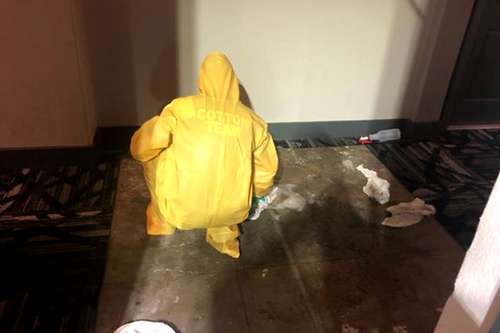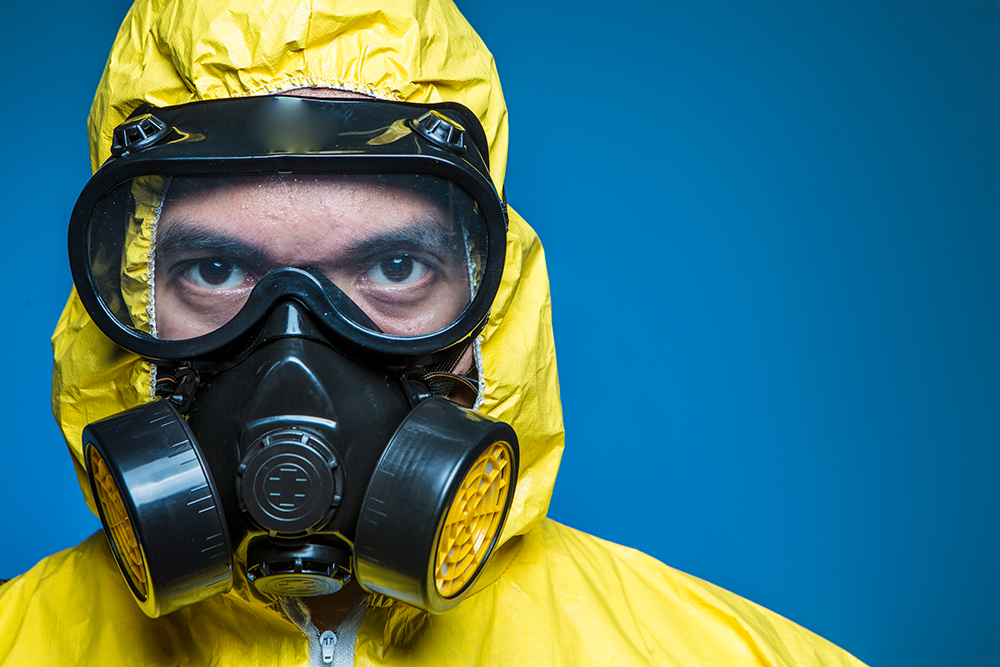Expert Biohazard Cleaning and Decontamination for Blood, Bodily Fluids, and Hazardous Materials
The prospective health threats associated with direct exposure to biohazards underscore the essential requirement for thorough handling and complete clean-up. As we browse the elaborate landscape of biohazard cleaning, understanding the subtleties of regulations, conformity, and the customized devices at play comes to be imperative in making sure a safe and complete purification process.
Health And Wellness Threats of Biohazard Exposure
Direct exposure to biohazards poses considerable wellness threats that can result in serious effects for neighborhoods and people alike. Biohazards encompass a wide variety of biological substances, including blood, physical liquids, mold and mildew, microorganisms, viruses, and other potentially contagious products. When people enter into contact with these biohazards, whether through mishaps, inappropriate handling, or environmental direct exposure, they encounter the risk of having serious health problems or conditions.
Among the primary health and wellness risks related to biohazard exposure is the transmission of contagious illness. Bloodborne virus such as HIV, liver disease B and C, and different microorganisms can be existing in biohazardous products, posturing a straight hazard to human health. Breathing in air-borne biohazards like mold and mildew spores or entering call with infected surface areas can likewise cause breathing problems, allergies, and other adverse health and wellness impacts.
Additionally, biohazard exposure can have long-term health effects, with some conditions materializing years after the preliminary contact (Blood Cleanup). As a result, it is critical to focus on appropriate biohazard cleaning and decontamination to minimize these wellness dangers and guarantee the safety of communities and individuals

Specialized Educating for Biohazard Cleanup
When it involves dealing with biohazard cleaning effectively and safely, specialized training plays a basic role in making sure correct decontamination treatments are complied with. Biohazard cleaning calls for particular expertise and abilities to efficiently mitigate threats linked with bloodborne virus, physical fluids, and harmful materials. Professionals learnt biohazard cleaning undergo extensive guideline on just how to safely deal with, eliminate, and get rid of biohazardous products to stop contamination and exposure.
Specialized training for biohazard clean-up covers a variety of crucial topics, including appropriate individual protective equipment (PPE) usage, bloodborne microorganism recognition, purification strategies, and contaminated materials disposal procedures. Individuals trained in biohazard clean-up are equipped with the required experience to assess contamination levels, identify potential risks, and carry out proper clean-up treatments in conformity with regulatory criteria.
Continuous training and education and learning are paramount in the field of biohazard clean-up to stay upgraded on the most recent purification technologies, safety procedures, and laws. By buying specialized training, biohazard clean-up experts can successfully react to emergency situation clean-up scenarios and guard both public health and the atmosphere.
Importance of Proper Decontamination Techniques
Using proper purification techniques is essential in biohazard cleaning to effectively remove unsafe materials and reduce health threats. Reliable decontamination not just guarantees the elimination of noticeable traces of blood, physical fluids, and other biohazards however also targets invisible virus that might pose severe wellness hazards otherwise effectively removed. By adhering to rigid decontamination methods, trained experts can dramatically decrease the threat of direct exposure to unsafe bacteria, viruses, and microorganisms that might lead to infections or illness.
Correct decontamination strategies include the usage of customized tools and disinfectants that are specifically designed to neutralize biohazards efficiently. Detailed cleansing and sanitation of polluted areas are important to prevent the spread of virus and guarantee a safe setting for occupants. Additionally, the proper disposal click reference of biohazardous waste adhering to decontamination treatments is vital in avoiding contamination of various other surface areas or people.

Tools and Tools for Safe Cleanup
When dealing with blood, bodily liquids, or view it dangerous products, biohazard cleansing specialists rely on specialized gear to lessen direct exposure risks and completely sanitize the damaged location. In addition, biohazard cleaning kits containing anti-bacterials, absorptive products, and biohazard bags are used to securely include and get rid of of polluted products.
Advanced cleaning devices like hospital-grade anti-bacterials, HEPA-filtered vacuum cleaners, and fogging equipments are utilized to sterilize surface areas and get rid of biohazards efficiently. Specialized equipment such as sharps containers and biohazard garbage disposal containers are made use of to safely take care of sharp objects and biohazardous waste materials. By utilizing the appropriate tools and devices, biohazard cleaning professionals can ensure a thorough cleaning process that prioritizes safety and decreases health risks for both employees and passengers of the damaged space.
Rules and Compliance in Biohazard Cleaning
Appropriate adherence to regulations and conformity standards is extremely important in biohazard cleaning to ensure the safety and security of both employees and the setting. Government firms such as OSHA (Occupational Security and Wellness Administration) and the EPA (Epa) have actually established details standards for biohazard cleaning treatments to lessen wellness threats and ecological contamination. These regulations cover an array of elements including the handling, transportation, and disposal of biohazardous clean up crime scene salaries materials, in addition to the needed training and safety devices needed for personnel associated with the cleaning process.
Biohazard cleansing firms need to remain updated with these guidelines to guarantee that their operations fulfill the required safety requirements. Failure to comply with these policies can result in extreme effects, including penalties, lawsuit, and jeopardizing the wellness of people and the environment. By adhering to strict guidelines and compliance actions, biohazard cleaning business can efficiently reduce threats and make sure a secure and thorough cleaning process for all parties included.
Verdict
To conclude, biohazard cleansing and decontamination call for customized training, appropriate strategies, and adherence to guidelines. Exposure to blood, physical liquids, and hazardous materials postures considerable health risks, making it critical to make use of the best tools and devices for secure cleanup. By adhering to stringent procedures and standards, professionals can properly mitigate the dangers connected with biohazard exposure and guarantee the safety of both themselves and others.
As we browse the detailed landscape of biohazard cleanup, recognizing the nuances of policies, compliance, and the customized tools at play comes to be critical in ensuring a risk-free and comprehensive purification procedure. (Blood Cleanup)
When it comes to dealing with biohazard cleaning effectively and securely, specialized training plays an essential function in making sure appropriate purification procedures are followed.Making use of proper decontamination methods is important in biohazard clean-up to effectively reduce and eliminate unsafe materials health risks. Furthermore, biohazard cleansing sets containing disinfectants, absorptive materials, and biohazard bags are made use of to securely include and get rid of of polluted things.
Government agencies such as OSHA (Occupational Security and Health Administration) and the EPA (Environmental Security Agency) have actually established specific guidelines for biohazard cleaning procedures to lessen wellness threats and ecological contamination.